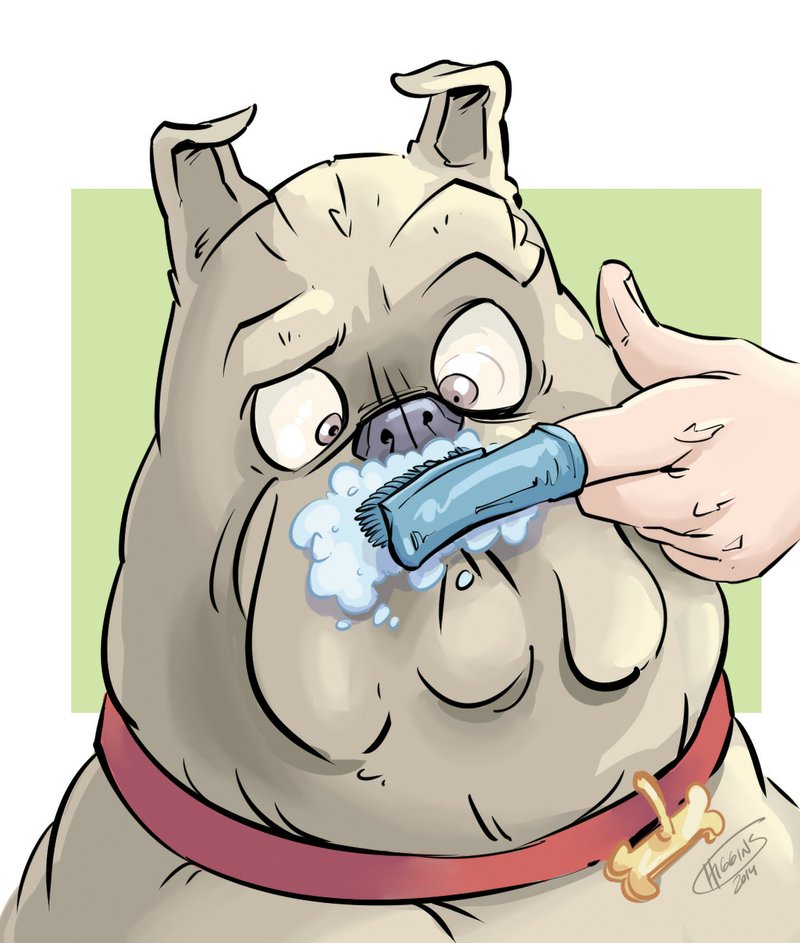My dog’s teeth aren’t as white as they used to be so I bought her a toothbrush and some Arm & Hammer toothpaste that’s supposed to taste like chicken. Emmy likes the toothpaste and licks it off the brush, but she doesn’t want the brush in her mouth. I’m about to give up. Any tips on how I can brush Emmy’s teeth? The brush looks a little big and doesn’t fit in her mouth very well.
Regular brushing can be part of a regimen to keep a dog’s teeth healthy throughout its lifetime, but it’s not something dogs take to naturally. They have to learn to accept a toothbrush or other tooth-cleaning implement. Before you stick a toothbrush in a dog’s mouth, remember how you felt during your first trip to the dentist, gripping the arms of the chair as the dentist loomed over you and began poking around inside your mouth.
Since your dog likes her toothpaste, you’re off to a good start. But put aside the toothbrush for now (permanently if it’s really too big for her mouth) and do as the American Society for Prevention of Cruelty to Animals suggests in its dental-health guide:
Start by gently massaging her lips with a finger for about a minute once or twice a day for a few weeks. Then move on to her teeth and gums.
Place a little doggy toothpaste on your finger, insert it into her mouth and lightly rub it along the front teeth, then the back. The dog toothpaste isn’t even necessary; a paste of baking soda and water works just as well, although it may not taste as good.
When your dog is used to having her teeth rubbed, then bring out the brush. Make sure it’s one that’s the right size for your dog’s mouth. You can also use a finger glove, which is a little rubber or plastic tube with soft bristles. Slip the glove onto one finger and put a dab of toothpaste on it, then rub it on your dog’s teeth. If your dog doesn’t like the glove or the brush, wrap your finger in a bit of gauze and brush with that.
When brushing, aim for proper technique (really, there is such a thing). Clean in circular motions, working on one small area at a time. The side of the teeth that touch the cheek are usually the dirtiest, so give them an extra swipe.
In between brushings, help your dog keep her teeth clean by providing a chew toy that massages the gums and scrapes away soft tartar. The Veterinary Oral Health Clinic has a list of approved dental chews and food on its website at vohc.org. They test and add to the list regularly. Some suggested edible chews are Canine Greenies, HealthiDent, VeggieDent and Purina Veterinary Dental Chewz.
The organization recommends products that you can put in your dog’s drinking water to fight plaque, as well as gels that you can apply to your dog’s teeth to help prevent plaque and tartar. You may be able to get the gel from your veterinarian.
You mentioned that your dog’s teeth aren’t as white as normal, so it could be time for a dental exam, which can be done as part of your dog’s overall annual wellness examination. If your dog seems to be experiencing any pain or his gums look red and tender, then take him to the vet immediately.
Happy brushing.
Believe it or not, dogs can get sunburned. Dogs with short or predominantly white fur are especially at risk of becoming sunburned and can become at risk for solar dermatitis or even skin cancer. As a preventive, apply a sunscreen with SPF 15 or higher that doesn’t contain para-aminobenzoic acid (PABA) to the tips of the ears, bridge of the nose, groin area, underbelly and other places with thinner fur or exposed skin.

